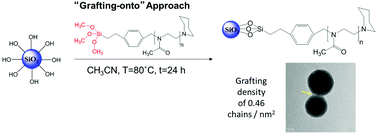Efficient synthesis of polyoxazoline-silica hybrid nanoparticles by using the “grafting-onto” approach
Abstract
Well-defined silica poly(2-methyl-2-oxazoline) nanoparticles were prepared via the “grafting to” method employing either click chemistry or silane coupling using different reaction conditions. In the first approach, alkyne-functionalized poly(2-methyl-2-oxazoline), P1, was prepared by ring opening cationic polymerization and clicked on azide-functionalized silica nanoparticles (SNPs), which led to the fabrication of hybrid nanoparticles. In the second approach, trimethoxysilane-functionalized poly(2-methyl-2-oxazoline), P2, was prepared similar to P1 and grafted on the surface of SNPs using coupling reactions between trimethoxysilane and hydroxyl groups of the silica nanoparticle. Hybrid particles were characterized by Fourier transform infrared spectroscopy (FTIR), thermogravimetric analysis (TGA), transmission electron microscopy (TEM), and elemental analysis (EA). The grafting density ranged from 0.183 chains per nm2 for the click chemistry approach up to 0.45 chains per nm2 when using trimethoxysilane-functionalized P2 in acetonitrile at 80 °C. The water-in-oil microemulsion approach resulted still in a relatively high grafting density of 0.353 chains per nm2 and has the advantage of a one-step process and mild reaction conditions.


 Please wait while we load your content...
Please wait while we load your content...